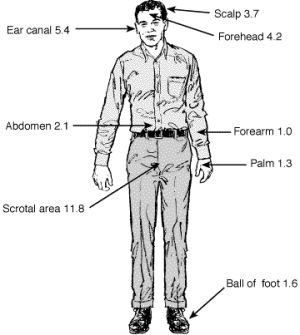| Field & Pesticide Work |

|
|
1 - Field & Pesticide Work
2 - Page 2 3 - Page 3 |

 HOME
HOME
Anybody expected to work in the field and/or with plants are presumed will be exposed to the vicinity of pesticides and therefore are required to take EPA's Worker Protection Standard (WPS) Training class. The purpose of WPS is to reduce the risk of pesticide poisoning and injuries among agricultural workers.
The slideshow will cover the basics of WPS and review health hazards and symptoms of heat stress, skin cancer, and the west nile virus.
Click Here to start the Safety in the Field Work Overview slideshow.
 |
Pesticide Use Overview
Use pesticide sprays in accordance with labels supplied on containers, and with the more detailed material safety data sheets (MSDS), available from your supplier.
Spot the hazard
Read labels and MSDSs carefully. Check spray equipment, safe handling procedures, protective equipment, operator training and awareness, and supervision of new and young workers.
Be aware pesticides enter the body through:
- absorption through skin contact, especially the eyes;
- inhalation of fumes, vapours and dusts;
- accidental swallowing while eating, drinking or smoking.
Here are some ways of improving spray safety:
- Use the least toxic pesticide available for effective control of insect, fungus or plant, as the case may be.
- Ensure only the recommended rate of pesticide is used.
- Wear protective clothing and equipment as described on the label and MSDS.
- Prepare only enough chemical for immediate use.
- Keep a record of each use and the results.
- Ensure equipment works properly and does not leak.
- Don't eat, drink or smoke while pouring, mixing or spraying.
- Don't pour concentrated pesticide into tanks above shoulder height.
- Avoid working alone if you are using a highly toxic pesticide; or have some form of mobile communication.
- Spray with minimal drift and preferably in low wind conditions.
- Never spray in high wind conditions.
- Use mechanical suction to transfer pesticides to spray tank.
- A vortex system can be used to mix pesticide concentrate with water before filling the spray tank.
- Prevent nozzles blocking by using correct filters and pesticide formulation. Ensure water and equipment are clean.
- Clear blocked nozzles by using a soft bristle brush or compressed air. Never suck or blow nozzles to clear them.
Clean up
- Thoroughly clean all spraying and protective equipment, where run-off will not create a hazard or contaminate the environment.
- Wash work clothing separately from domestic clothing, or use disposable clothing.
- Wash yourself well after a spray operation.
- After handling pesticides, wash hands with soap and water before eating, drinking, going to the toilet or smoking.
Take precautions
- Provide a first aid kit that includes a towel, clean clothing, a resuscitation mask for expired air resuscitation, disposable eye wash bottle and eye wash solution, soap, nailbrush, and clear instructions on what to do with this equipment.
- Keep fresh water close by for washing.
- Advise someone where you will be working and how long you intend to be gone. Otherwise ensure you have a two-way radio for emergency calls.
- Have a family member or other person at the farm attend first aid classes.
- Check the labels, MSDSs or other safe handling guides for your pesticides, to ensure you have the correct antidotes, emergency equipment and facilities required by labels and MSDSs.
- Stop work immediately and seek medical attention if there is any sign of muscular spasm, blurred vision, excessive saliva or difficulty breathing. Suspect pesticide poisoning with any of these symptoms.
- If regularly using pesticides, an annual medical examination is recommended before and after the spraying season, and more frequently with some chemicals.
 |
For skin contact: Wash with soap and water, and rinse with clean water. Remove any contaminated clothing, and seek medical advice.
The skin on various body parts does not absorb pesticides at the same rate. Picture to the right shows dermal absorption rates based on a numerical scale in which the value of 1 for the forearm represents the lowest dermal absorption rate. That value forms the basis for assignment of values to the other body parts.
For eye contact: Hold eye open under running water for 15 minutes. Seek medical advice.
For swallowing: Ring the Poisons Information Center.
| [1] 2 3 Next >> |
